Navigation
Homepage
About Us
Additional Resources
Exhibit 2013
Find Articles and Books
Historical Newspapers
Reference & Research
Research Guides
Tutorials
Contact Us
Latin America and the Caribbean is a region special for many reasons. Its rich culture, dynamic politics, and varied economies provide much space for study and engagement. However, as Peter Bakewell argues in “A History of Latin America,” what makes Latin America and the Caribbean a region unique from other parts of the world is its long history of cultural, political, racial, and ethnic mixing, otherwise known as mestizaje. Through more than 500 years of constant intermixing of different civilizations (broadly defined as Indigenous, European, African, and Asian), new types of societies have emerged, in different ways and with different features. The societies that inhabit these lands are a result of this mestizaje, whether genetic or cultural, which provides the basis for the ways in which politics work, their culture redefined, literary works created, languages spoken and written, and religions followed and practiced. Latin America and the Caribbean, is thus a true kaleidoscope of human civilizations, experiences, and histories, all brought together by that same diverse process of human interaction to achieve unity in diversity.
Latin American and Caribbean Studies Library Collection at the University of Illinois at Urbana-Champaign
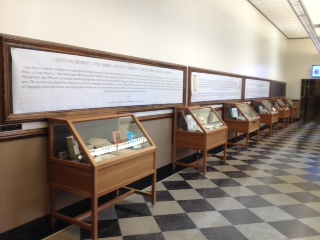 The Latin American and Caribbean Studies collection is considered to be one of the best in the nation. With more than 610,000 volumes and close to 300 serials from Latin America in Spanish, Portuguese, French and several indigenous languages, our collection ranks in the top five collections nationwide and is the largest in the Midwest. From rare 18th century correspondence to hundreds of videos, documentaries, CDs, and around 32,000 maps our collection is extraordinarily comprehensive and distinctively deep.
The Latin American and Caribbean Studies collection is considered to be one of the best in the nation. With more than 610,000 volumes and close to 300 serials from Latin America in Spanish, Portuguese, French and several indigenous languages, our collection ranks in the top five collections nationwide and is the largest in the Midwest. From rare 18th century correspondence to hundreds of videos, documentaries, CDs, and around 32,000 maps our collection is extraordinarily comprehensive and distinctively deep.
Our collection includes online access to a large number of newspapers and magazines from all over the region through portals such as Latin American Newstand, Lexis-Nexis Academic Universe, Access World News, PressDisplay, and others. Digital access to resources and material from and about the region has become an integral part of the collection. We are subscribed to all the major databases for academic journal resources including: the Hispanic American Periodical Index (HAPI), Handbook of Latin American Studies, Oxford Bibliographies: Latin America, and also EBSCO, Infotrac, JSTOR, and a host of other disciplinary databases. We are also members of LAMP (formerly the Latin American Microfilm Project) of the Center for Research Libraries, which gives us access to a comprehensive microform collection of historic primary material, from politics to culture, covering the past five centuries. Recently, our library acquired a promising new database called “Confidential Prints: Latin America, 1833-1969,” containing official British documents pertaining to revolutions, territorial changes and political movements, foreign financial interests, industrial and infrastructural development (including the building of the Panama Canal), wars, slavery, immigration from Europe and relations with indigenous peoples, amongst other topics.
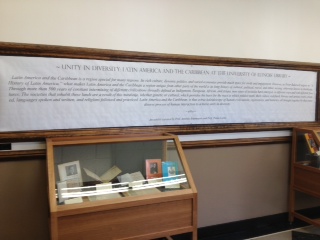
For the most part of the last century’s worth of acquirement, including numerous purchasing trips to the region, an aggressive and comprehensive amassing program has made the content of the collection robust in most of the forty countries in Latin America and the Caribbean. However, traditional strengths have been Brazil and the Andes (especially Peru and Ecuador), Argentina, Mexico, Mesoamerica, Colombia, Venezuela, Chile, and recently Central America and the Caribbean. The collection is more than equipped to support teaching, studying, and research in most disciplines, but special disciplinary strengths are the social sciences, the humanities, languages and literature. Our material in the Andean language of Quechua is particularly strong.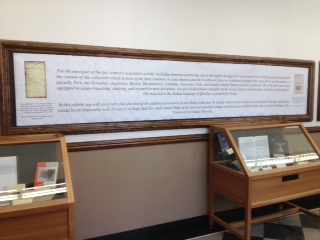
In this exhibit you will see a very slim selection of the plethora of resources in our library collection. To include resources for all topics, personalities, countries, and regions would be an impossible task. However, we hope that this sample hints at the rare and sometimes unique material about and from Latin America and Caribbean at the University of Illinois’ libraries.
Popular Culture: Sport, Music, & Food
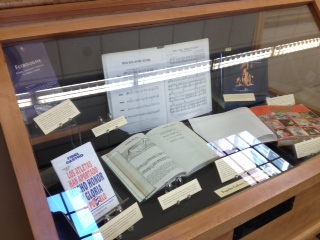 The people from Latin America and the Caribbean are also known for their rich and diverse expressions of popular culture. Some would argue that it is in Latin America and the Caribbean popular culture that we can see how diverse this region is and how powerful many of these cultural expressions are, which have exerted their influence not only in Latin America but also globally. Soccer and baseball, salsa and merengue, cumbia and ranchera, tango, samba and bossa nova, chocolate, tortillas, rice and beans are only a few of the cultural distinctions that make this region so unique and exciting.
The people from Latin America and the Caribbean are also known for their rich and diverse expressions of popular culture. Some would argue that it is in Latin America and the Caribbean popular culture that we can see how diverse this region is and how powerful many of these cultural expressions are, which have exerted their influence not only in Latin America but also globally. Soccer and baseball, salsa and merengue, cumbia and ranchera, tango, samba and bossa nova, chocolate, tortillas, rice and beans are only a few of the cultural distinctions that make this region so unique and exciting.
- Alabarces, Pablo, compilador, Carlos Alberto Máximo Pimenta et al., Futbologías: fútbol, identidad y violencia en América Latina. Buenos Aires: Consejo Latinoamericano de Ciencias Sociales, 2003. Call Number: 796.334098 F989
Our Latin American and Caribbean sport collection is a growing interest for our Librarian. With the Upcoming World Cup and Olympic Games in Brazil, sport and its relation to politics, identity, economics, and society, this field of scholarship is due to have its share of attention.
- Castro, Fidel, Los atletas han aportado mucho honor y gloria al pueblo. La Habana: Editora Política, 1999. Call Number: 796.097291 C27a
Fidel Castro is known for his love of sport and baseball. Here we have a rare pamphlet of a speech he gave outlining the importance of sport for the Revolution.
- Caymmi, Dorival, Cancioneiro da Bahia. São Paulo: Livraria Martins, 1947. Call Number: 784.4 C31C
Our music Library has several “treasures” of Latin American music and dance. This is a good example of a rare piece from Bahia.
- Jobim, Antonio Carlos, The best of the bossa novas. New York: MCA Music, 1966. Call Number: M1690.18J62 M2
Antonio Carlos Jobim is one of Brazil’s most famous musicians with masterpieces like Girl from Ipanema.
- Rondon, César Miguel, El libro de la salsa: crónica de la música del caribe urbano. Caracas: Distribuido exclusivamente por Merca Libros, 1980. Call Number: ML3475 R661980
The Caribbean has produced different and very popular musical genres. One of them is Salsa. This book documents the different protagonists and styles of this source of Caribbean identity and global form of entertainment.
- McNeil, Cameron L., Chocolate in Mesoamerica: a cultural history of cacao. Gainesville: University Press of Florida, 2006. Call Number: 972.01 C451
Food is at the center of our lives. Without it we cannot live. Yet food, its preparation, ingredients, and use is also a cultural phenomenon of identity. In this recent piece of scholarship, chocolate is studied in its Mesoamerican origins.
- Lauer, Mirko, La Olla de Cristal: Mirando el future de la cocina peruana. Lima: Fondo Editorial, Universidad de San Martín de Porres, 2012. Call Number: new item.
A recent book of Peruvian gastronomy by award winning author and professor at the Universidad de San Martín de Porres.
Public Figures & Politics
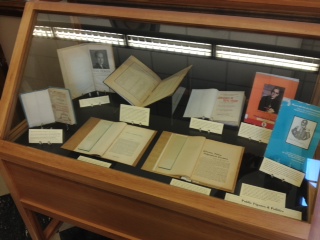 Latin American and Caribbean public figures and prominent politicians abound. From pre-Columbian, colonial, early republican and contemporary periods, some of these leaders have shaped the way politics, economics, religion, and the nation is conceptualized. You will see that these leaders come from very diverse ethnic, racial, social, national, gender, ideological, and cultural backgrounds. This diversity of public figures is what makes Latin America and the Caribbean a truly dynamic political and cultural region.
Latin American and Caribbean public figures and prominent politicians abound. From pre-Columbian, colonial, early republican and contemporary periods, some of these leaders have shaped the way politics, economics, religion, and the nation is conceptualized. You will see that these leaders come from very diverse ethnic, racial, social, national, gender, ideological, and cultural backgrounds. This diversity of public figures is what makes Latin America and the Caribbean a truly dynamic political and cultural region.
- Landaeta Rosales, Manuel, Hoja de servicios del libertador Simón Bolívar, formada por el general Manuel Landaeta Rosales, quien la dedica al señor doctor Juan Pablo Rojas Paúl, presidente constitucional de la república, el 28 de octubre de 1889. Caracas, Impr. y Lit. del Gobierno Nacional, 1889. Call Number: Q. 987 B63Wl
Considered one of the most important political figures of his time, Simón Bolivar was key figure in the wars of independence of northern South America, in what is today Venezuela, Colombia, Ecuador, Panama, Bolivia, and Peru. In this very rare book we have the General’s battle log published at the time of the 100th anniversary of his birth.
- Guevara, Ernesto, La Liberación económica de Cuba: conferencias. La Habana: Impr. Nacional de Cuba, Ministerio de Educación, Gobierno Revolucionario, 1960. Call Number: 330.97291 UN3L
Rare pamphlet of a speech given by Dr. Ernesto “Ché” Guevara in 1960 laying out his Revolutionary vision for Cuban political and economic sovereignty.
- Juárez, Benito, Miscelanea: comunicados, respuestas, iniciativas, dictámenes, informes, brindis, etc. México: A. Pola, 1906. Call Number: 972 J87M
Benito Juárez, author of this rare miscellaneous collection of communications, replies, speeches, letters and more, was President of Mexico (1858-1872), and although politically trained European, he was of indigenous background, making him the first indigenous President in Latin America.
- Pereira de Carvalho, José Lopes, D. Pedro I e a constituição do imperio. Rio, Brasil: J. Leìte, 1916. Call Number: 342.81 P41D
A very rare study of Brazil’s first Emperor, D. Pedro (1822-1831), after their independence from Portugal in 1822.
- Pérez Memén, Fernando, La política religiosa de Toussaint L’Ouverture en Santo Domingo. Santo Domingo, República Dominicana: Museo del Hombre Dominicano, 1984. Call Number: 277.297 P415P
Our collection has noteworthy material for Caribbean Studies, as this pamphlet on the religious politics of Haitian revolutionary Toussaint L’Ouverture (1791-1803) in Santo Domingo, Dominican Republic exemplifies.
- Perón, Eva, Eva Perón señala el camino del civismo a la mujer argentina. Argentina: [s.n.], 1950. Call Number: 320.158 P42E
Representing the important role of women in Latin America, we have a rare pamphlet of a speech given by Eva Perón in 1950 advocating for the significance of women in Argentina.
- Romero, Oscar A., Monseñor Oscar Arnulfo Romero: su diario desde el 31 de marzo de 1978 hasta jueves 20 de marzo de 1980. San Salvador, El Salvador: Arzobispado de San Salvador, 2000. Call Number: 282.092 R664ro
Latin American religious leaders are known for defending the poor classes in a movement called “Liberation Theology.” We have in Illinois the Diary of Monsignor Oscar Romero (El Salvador, 1917-1980), who died defending the human rights of the “voiceless” popular classes.
- Tupac-Amaru, José Gabriel, Genealogía de Tupac Amaru. Lima: [s.n.], 1946. Call Number: 985 T832G
In “Genealogía de Tupac Amaru” we have a collection of documents relating to the Inca leader José Gabriel Tupac Amaru (1777), who claimed to be a direct descendant of the last Inca ruler of the sixteenth century in Perú.
Archaeology & Anthropology
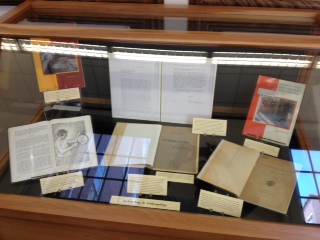 The University of Illinois has a rich history of eminent Anthropologists and Archeology. One of them is Professor Julian H. Steward (1952-1972), who is known for developing the theory and methodology of “cultural ecology,” as well as his inquiry into the process of modernization. Another eminent anthropologist was Oscar Lewis (1948-1970), who, while controversial for his theory on “culture of poverty,” left a profound mark in the discipline and a rich archive at Illinois. As a result of this anthropological activity on campus our archival and library collection on these disciplines are robust.
The University of Illinois has a rich history of eminent Anthropologists and Archeology. One of them is Professor Julian H. Steward (1952-1972), who is known for developing the theory and methodology of “cultural ecology,” as well as his inquiry into the process of modernization. Another eminent anthropologist was Oscar Lewis (1948-1970), who, while controversial for his theory on “culture of poverty,” left a profound mark in the discipline and a rich archive at Illinois. As a result of this anthropological activity on campus our archival and library collection on these disciplines are robust.
- Letter by Julian H. Steward to Sidney W. Mintz dated March 15, 1957. Julian H. Steward Papers, 1842-1980, 15/2/21, Box 2, Mintz, Sidney, 1952-1959, University Archives, University of Illinois.
In this letter Professor Steward discusses the theoretical problems with the concept of “Circum-Caribbean” with former student Sidney Mintz, who also went on to have a stellar career as an anthropologist. Together they had worked with other future prominent scholars such as Eric Wolf, Robert Manners, Raymond Scheele, and Elena Padilla Seda in the book “The People of Puerto Rico” (1956).
- Whitten, Norman, et. al. Second Edition. Amazonía ecuatoriana: La otra cara del progreso. Ediciones mundo shuar, 1981. Call Number: 572.9866 Am11
The University of Illinois has had its share of preeminent anthropologists. Most recently, renowned Professor Emeritus Norman Whitten has published numerous books and articles on the peoples of Ecuador and the Amazons.
- Berthon, Paul André Antoine, Étude sur le précolombien du bas-Pérou. Paris: Impr. nationale, 1911. Call Number: 913.85 B46e
While our Latin American and Caribbean Studies collection mainly consists of material written in Spanish and Portugues with some material in several indigenous languages, there is other material writen in other European languages. This is a rare book writen in French and published in Paris about pre-Columbian civilizations in Peru.
- Olmedo Vera, Bertina, Los Templos rojos del recinto sagrado de Tenochtitlan. México, D.F.: Instituto Nacional de Antropología e Historia, 2002. Call Number: 572 M5722c no.439
Recent scholarship on the temples of Tenochtitlan in Mexico.
- Peralta Flores, Araceli, Hallazgos en el Metro de la ciudad de México: arqueología y acervos. México, D.F.: Instituto Nacional de Antropología e Historia, 1996. Call Number: 972.53 P41h
The modern city of Mexico City was constructed over the Aztec city of Tenochtitlan. Excavations undertaken between 1982-1984 found remains of this city under Mexico City’s Metro routes.
- Rodríguez del Busto, N., La cultura incaica: trabajo leído i aprobado en el Congreso de Historia e Geografía, en la sesión del 13 de octubre de 1924, reunido en Buenos Aires. Tucumán: Miguel Violetto, 1924. Call Number: 980.00498 IN2R
Rare book that describes the “treasures,” “progress,” and “culture” of the once almighty Inca Empire.
Languages & Literature
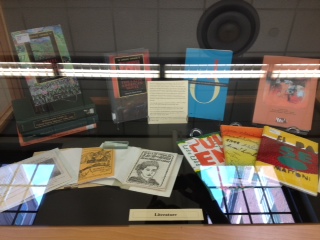 The UIUC Library owns several thousand examples of Brazilian Literatura de Cordel. Produced in Northeast Brazil and sold in fairs and street markets, where they are exhibited on cords and thus the name “string literature”, each book contains a single text, such as a popular poem, song or even novel. They are printed on small-sized inexpensive paper and the covers usually have a woodcut, sometimes signed by the artist, featuring an aspect of the text or a photograph of the author or person being honored. While the majority were published in the 1920s and 1930s, there has been a resurgence of interest in them in recent years.
The UIUC Library owns several thousand examples of Brazilian Literatura de Cordel. Produced in Northeast Brazil and sold in fairs and street markets, where they are exhibited on cords and thus the name “string literature”, each book contains a single text, such as a popular poem, song or even novel. They are printed on small-sized inexpensive paper and the covers usually have a woodcut, sometimes signed by the artist, featuring an aspect of the text or a photograph of the author or person being honored. While the majority were published in the 1920s and 1930s, there has been a resurgence of interest in them in recent years.
- Carvalho, Elias A. de. Dona Beja de Araxá na história dos Gerais. Petrópolis, RJ: E. A. de Carvalho, 1987. Call Number: 869.9 C2545DB
- Carvalho, Elias A. de. A morte de Lampião. Rio de Janeiro: Gráfica Dantas, 1984. Call Number: 869.9 C2545M
- Cavalcante, Rodolfo Coelho. Castro Alves não morreu: vive na alma do povo. Brazil: s.n., 1985. Call Number: 869.9 C3143CAS
The UIUC Library owns a small but important collection of Argentinian and Brazilian cartonera books. The Cartonera publishing house was started in Buenos Aires in 2003 by writers and artists who wanted to make their works more accessible to the average person as well as challenge the current publishing system. All of the Cartonera books are made from recycled cardboard collected by cartoneros, or garbage pickers in the streets. The books are printed on cheap paper and sewn together by hand in small workshops. Once the books are assembled, artists paint the covers: most often usually they spell out the book’s title in bright colors, though, in some cases, they add figural motifs; in many cases they incorporate the cardboard’s original markings. No two covers are alike and thus each book is unique. The cartonera phenomenon soon spread to other countries in Latin America.
- Cucurto, Washington. 1999: poemas de siempre, poemas nuevos y nuevas versions. Buenos Aires, Argentina: Libros de Eloísa Cartonera, 2007. Call Number: 869.3 C892mi
- Casas, Fabián. El bosque pulenta. Buenos Aires: Eloísa Cartonera, 2003. Call Number: 869.3 C2641b
- Mattoni, Silvio. El paseo. Buenos Aires: Eloísa Cartonera, 2003. Call Number: 869.3 M4362pa
The UIUC Library houses an extraordinary rich collection of Latin American and Caribbean literature, including all types of genres: novels, short stories, poems, and plays. Visitors to the Library often comment on the depth and breadth of the collection, which dates back to the early twentieth century. Particularly strong are the holdings for Colombian literature, made possible through a donor’s generous gifts. To support research and study of this amazing literary collection is a complementary one for literary criticism. Several examples are presented here, including a suite of exhaustive bibliographies for the Colombian author Gabriel Garciá Márquez written by a former UIUC librarian.
- The Cambridge companion to Gabriel Garciá Márquez. Edited by Philip Swanson. New York: Cambridge University Press, 2010. Call Number: PQ8180.17.A73 Z6155 2010
- Kristal, Efraín. The Cambridge companion to the Latin American novel. Cambridge; New York: Cambridge University Press, 2005. Call Number: PQ7082.N7 C36 2005
- Nuevos hispanismos interdisciplinarios y trasatlánticos. Edited by Julio Ortega. Madrid: Iberoamericana; Frankfurt am Main: Vervuert ; México, D.F. ; Bonilla Artigas, 2010. Call Number: 460 N8896
- Memorias: Segundo Congreso Internaciona : Literatura sin fronteras. Edited by Ramón Alvarado. Mexico: Universidad Nacional Autónoma de México, 1999. Call Number: 869.09 C760m
Art & Religion
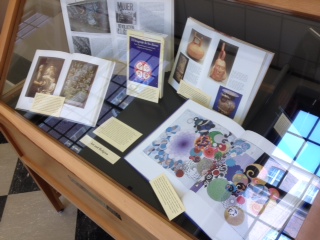 As long as humans have inhabited the region known today as Latin America, they have made artifacts and in a wide variety of media. Many of these objects incorporate religious themes, which might derive from indigenous practices or have been brought in from European Christian and African societies. The nexus of art and religion was especially strong in the pre-Colombian and colonial periods, though it still continues today, as evident in many contemporary paintings. Another recurring theme in Latin American art is war, in response to the region’s many armed conflicts and instability. Latin American artists have portrayed various aspects of war as well as had their images actively used during wartime. Cultural and social diversity is another key subject in the artifacts of the region and with each generation this theme takes on new directions and new meanings.
As long as humans have inhabited the region known today as Latin America, they have made artifacts and in a wide variety of media. Many of these objects incorporate religious themes, which might derive from indigenous practices or have been brought in from European Christian and African societies. The nexus of art and religion was especially strong in the pre-Colombian and colonial periods, though it still continues today, as evident in many contemporary paintings. Another recurring theme in Latin American art is war, in response to the region’s many armed conflicts and instability. Latin American artists have portrayed various aspects of war as well as had their images actively used during wartime. Cultural and social diversity is another key subject in the artifacts of the region and with each generation this theme takes on new directions and new meanings.
- Scott, John F. Latin American Art: Ancient to Modern. Gainesville: University Press of Florida, 1999. Call Number: 709.8 Sc84l (Architecture & Art); N6502 .S367 1999 (UGL)
The people living in the region today known as Latin America have been producing art works for thousands of years. Scott’s survey is a wonderful overview of this rich history and an excellent example of a library resource aimed at students and the general reader.
- El lenguaje de los dioses: arte, chamanismo y cosmovisión indígena en Sudamérica. Edited by Ana María Llamazares and Carlos Martínez Sarasola with an epilogue by Jacques Mabit. Buenos Aires: Editorial Biblos, 2004. Call Number: 709.7 L547
For centuries the inhabitants of Latin America have expressed their beliefs in the cosmos and deity/ deities through the visual arts. Their sentiments were not just captured in a physical form; these forms played an active and key role in rituals and culture.
- Donahue-Wallace, Kelly. Art and Architecture of Viceregal Latin America, 1521-1821. Call Number: 709.809031 D714a (Architecture & Art)
The European presence in Latin America led to the creation of new art forms. One development, begun in the early eighteenth-century, was the painting form known as castas painting, which represents the various mixed-race people living in colonial Latin America. These painting tend to follow the same formula: a father and mother are depicted in clothing associated with their race and social status and are accompanied by their mixed-race child. Often several family portraits, each presenting a different racial combination, are juxtaposed. The original purpose of these paintings is not known.
- Craven, David. Art and Revolution in Latin America: 1910-1990. New Haven and London: Yale University Press, 2002. Call Number: 709.80904 C855a (Architecture & Art); N6502 .C735 2002 (UGL)
The twentieth century witnessed three historic revolutions in Latin America: Mexico (1910), Cuba (1959-89) and Nicaragua (1979-90). Latin American artists were not silent during these armed conflicts: instead, with they responded actively and variously to them with their pencils, paint, clay and their media. Craven’s book chronicles in word and image these artists’ revolutions.
- Queloides: Race and Racism in Cuban Contemporary Art = Queloides: raza y racismo en el arte Cubano contemporáneo. Edited by Alejandro de la Fuente and curated by Alejandro de la Fuente & Elio Rodríguez Valdés. Pittsburgh, Pa. : Mattress Factory ; Distributed by University of Pittsburgh Press, 2010. Call Number: Q 709.7291 Q33 (Architecture & Art)
Since the colonial period race has been a key theme in Latin American art. This exhibition catalog brings together the work of several well-known Cuban artists who use their art works to make statements about the role of race in contemporary Cuban life.
- Sardenberg, Ricardo. Arte contemporânea no século XXI: 10 brasileiros no circuito internacional. Rio de Janeiro : Capivara, 2011. Call Number: N6655.6 .S27 2011
Beatriz Milhazes, whose Beleza Pura (“Pure Beauty”) is shown here is one of the most important Brazilian artists living today. Her large brightly-colored paintings mix forms from Brazilian cultural imagery with visual references to western Modernist painting.
Environment & Travel
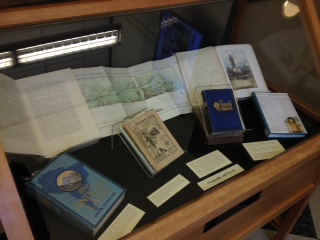 The UIUC Library should be the first stop for the scholar and student wishing to visit Latin America or wanting to learn about earlier explorers to the region. The Library houses a world-class collection of travel books, written in a wide variety of languages by authors from many countries, as well as descriptive texts about the flora and fauna of the region. While most of these are housed in the Main Stacks and can circulate to patrons, the older and rare items are kept in the Rare Book and Manuscript Library and must be consulted there. Books in this collection contain not only text but illustrations and maps, many of which are quite large and detailed.
The UIUC Library should be the first stop for the scholar and student wishing to visit Latin America or wanting to learn about earlier explorers to the region. The Library houses a world-class collection of travel books, written in a wide variety of languages by authors from many countries, as well as descriptive texts about the flora and fauna of the region. While most of these are housed in the Main Stacks and can circulate to patrons, the older and rare items are kept in the Rare Book and Manuscript Library and must be consulted there. Books in this collection contain not only text but illustrations and maps, many of which are quite large and detailed.
- A wonderful example of the kind of maps to be found in these works is Vue Générale panoramique du canal interocéanique de Panama in André Bresson’s Bolivia. Paris: Challamel aîné, 1886, a work that chronicles the Frenchman’s seven year voyage to and in the country. The map not only informs us about the trajectory of the canal, the elevation of the surrounding area and the various towns along the way but also the central role of the canal in European travels to the western coast of the South American continent. Call Number: 918 B75B
- Osborn, Chase S. The Andean Land (South America). 2 Vols. Chicago: A. C. McClurg & Co., 1909. Call Number: 918 OS2A
An amateur explorer and politician (He served as governor of Michigan from 1911-1913.) Osborn gives a lively account of his trip around South America that includes descriptions of places visited, reflections on customs and people encountered and, perhaps most interesting, long discussions of commodities and trade, particularly with the US.
- H. Hesketh Prichard. Through the Heart of Patagonia. London: William Heinemann, 1902. Call Number: 918.2 P93T
This beautifully rendered painting illustrates the belief that men of Tehuelche tribe of Patagonia stood on horses to better observe hunting game, in this case the Guanaco, a type of camelid.
- El Turista: Guía general del turismo en Chile. Santiago? 1929? Call Number: 918.3 G16T
Unlike the other books in this case, this one was intended for use in actual travel. It contains not only descriptions but prices and transportation schedules as well. We have no way of know if this book was ever used to help a traveler through Chile.
The UIUC Library is especially strong in its holdings of Amazonia and includes natural history, scientific tracts and popular writings. Two examples are presented here.
- Hugh Raffles. In Amazonia: A Natural History. Princeton and Oxford: Princeton University Press, 2002. Call Number: 306.09811 R123i
Raffles Natural History is one of many works the Library owns on the unique environment of the Amazon River.
- Davenport, William Henry. The Amazon and Its Wonders. London: Thomas Nelson and Sons, 1881. Call Number: 918.1 AD19A
A note of the flyleaf tells us that David Mitchell received this book as a prize for attending 44 unnamed events (possibly having to do with South America or travel?) held on Sunday.